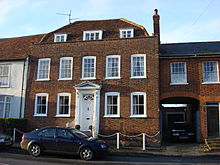 |
| John Aldridge |

A slight by the by here as Great Bardfield also played an important role in the history of the Oxlip, a rare plant only found in the UK where Essex, Suffolk and Cambridgeshire meet. In 1842 Henry Doubleday and later Charles Darwin did tests on Oxlips conducted in Great Bardfield, concluding that they were not Cowslip/Primrose hybrids as previously assumed and for a while the plant was called the Bardfield Oxlip to differentiate from the common cowslip/primrose hybrid or False Oxslip.Confusing or what. When I was a girl in Essex, cowslips were called Peggles......
I was actually born in the village of Black Notley, just outside Braintree, and in the 17th century a botanist called John Ray was also born there, one of the earliest English parson-naturalists, whose classification of plants was the first step towards modern taxonomy - he classified by differences or similarities that emerged from observation. He was the first person to produce a biological definition of what a species is. ('Thus, no matter what individuals or the species, if they spring from the seed of one and the same plant, they are accidental variations and not such as to distinguish a species' from Ray's 1686 History of Plants).

Still, back to Bawden......he was a solitary child, drawing, or wandering with a butterfly net or microscope. At the age of seven he was enrolled in Braintree High School - the same one I went to I assume. He went to Cambridge School of Art where he became interested in William Morris and other Victorians.He met Ravilious while training under Paul Nash at the Royal College of Art School of Design in London, and later produced work for London Transport, Fortnum and Mason and London Underground. He also collaborated with John Aldridge on lino-cut wallpapers. During the Second World War he served as official war artist, painting watercolours in Iraq. He taught at Goldsmiths, then the Royal College of Art; in 1968 he became a tutor at the Royal Academy and a senior lecturer at Leicester College of Art and Design.

Eric Ravilious was also appointed war artist in 1940, but died accompanying an RAF air sea rescue mission off the coast of Iceland in 1942.


Richard Bawden, Edward's son, also born in Black Notley, is an artist in a similar vein to his father, creating lino cuts and etchings of domestic scenes.

S So all in all Braintree has a lot to be proud of!!! I think I might even be proud of it myself!




 Commentator and stand-up comedian Mark Steel has presented several radio
and television programmes, and appeared on Have I Got News for You and
Never Mind the Buzzcocks. In 2006 he published 'Vive La Revolution: A
Stand-up History of the French Revolution', and in 2000 stood as a
candidate in the London Assembly elections.
Commentator and stand-up comedian Mark Steel has presented several radio
and television programmes, and appeared on Have I Got News for You and
Never Mind the Buzzcocks. In 2006 he published 'Vive La Revolution: A
Stand-up History of the French Revolution', and in 2000 stood as a
candidate in the London Assembly elections.